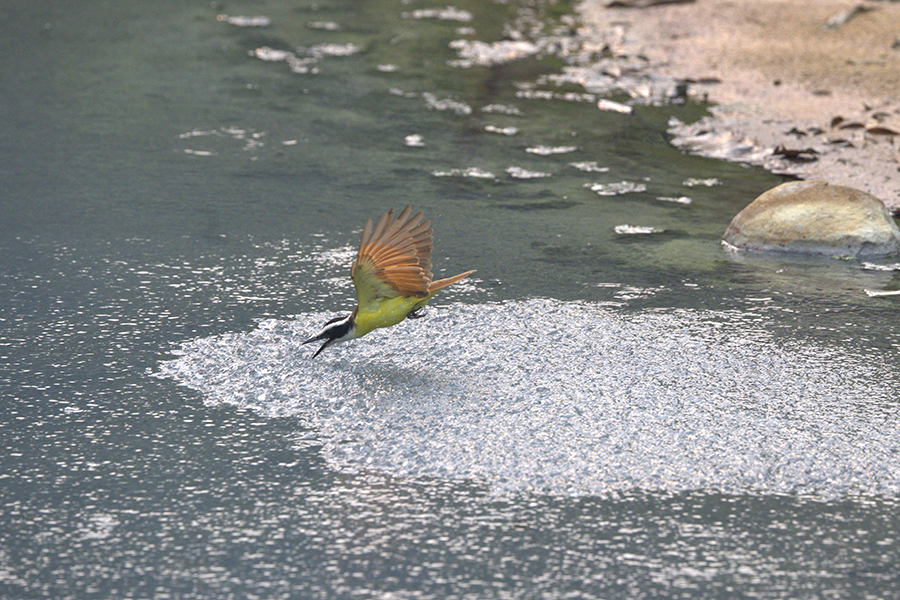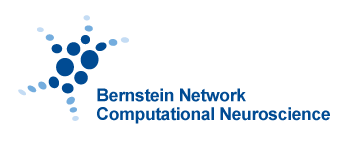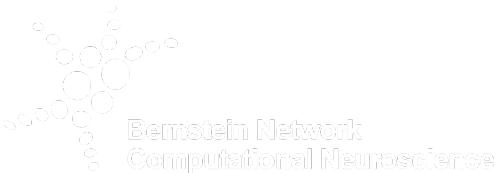Smarter together: Large shoals of fish make better decisions
Free-living groups of fish recognize dangers more quickly and react more accurately the larger they are.

An attack by a bird causes a school of sulphur mollies (Poecilia sulphuraria) to dive underwater. The photo was taken on the El Azufre River in the Mexican state of Tabasco. Photo: Korbinian Pacher IGB & SCIoI
Bernstein member involved: Pawel Romanczuk
When a bird of prey attacks, every second counts for fish: dive or stay? A wrong decision can be fatal – either because it comes too late or because a threat is mistaken for a harmless noise. A study by researchers from the Cluster of Excellence “Science of Intelligence” (SCIoI), the Humboldt-Universität zu Berlin (HU) and the Leibniz Institute of Freshwater Ecology and Inland Fisheries (IGB) now shows that larger shoals of fish not only make such decisions faster, but that they can also make better decisions. The results, which have just been published in the renowned journal Science Advances, provide the first evidence to date under natural conditions that large groups of animals can overcome two classic trade-offs: recognizing real dangers without reacting to every disturbance and making quick decisions without losing accuracy.
Lightning-fast decisions with thousands of participants
For their study, behavioral biologists Korbinian Pacher from the IGB and Prof. Dr. Jens Krause from the Albrecht Daniel Thaer Institute for Agricultural and Horticultural Sciences, together with other colleagues from HU Berlin, studied shoals of sulphur molly (Poecilia sulphuraria), a species of fish living in the hot, sulphur-rich springs of the El Azufre River in the Mexican state of Tabasco. The conditions there are extreme: oxygen deficiency, high temperatures, and birds of prey such as kingfishers and kiskadees, which regularly hunt the fish. The collective defense strategy of the sulphur molly is particularly interesting: as soon as a shoal perceives a potential danger, the fish dive synchronously, creating wave patterns visible on the water’s surface – like Mexican waves. If it is indeed an attack, a series of further “wave dives” follows. If the stimulus is harmless, the fish dive down only once. This behavior was a stroke of luck for the researchers, as it allowed them to gain a precise insight into how groups of animals make decisions about potential dangers for the first time.
Recognizing danger – as a team
In over two hundred documented events, the researchers compared the behavior of shoals during real attacks and harmless bird flyovers. They focused on the kiskadee, a particularly difficult predator to spot: instead of diving loudly, it attacks in flight, with only its beak briefly touching the water, which is visually almost indistinguishable from the harmless movements of other birds. The result: larger shoals were significantly better at distinguishing between real danger and false alarms. While reactions to real threats increased with group size, reactions to harmless stimuli remained constant. In other words, the shoals did not become more sensitive, but more precise. This represents a real improvement in decision-making.
“We have known for a long time that animal groups can make impressive collective decisions,” says study leader Korbinian Pacher, a doctoral student at the IGB. “But theoretical models and laboratory experiments only take us so far in researching this phenomenon. We were interested in whether collective intelligence also works where it really counts, namely under chaotic, noisy, real-world environmental conditions.”
“Studying collective decision-making behavior under conditions where a wrong decision has real consequences is hardly possible in the laboratory, which is precisely why it was so important to go back into the field with this question,” adds Jens Krause, also an author of the study and professor of fish biology and ecology at HU as well as head of the Department of Fish Biology, Fisheries, and Aquaculture at the IGB.
Not just larger, but smarter too
Decision theory often assumes a dilemma: those who react quickly make more mistakes; those who hesitate too long miss their chance to escape. But the shoals of sulphur molly not only became more accurate, they also became faster. The larger the shoal, the shorter the time between the first dive and the collective decision to continue defending themselves. “In the largest shoals, the detection rates were almost perfect, with nearly 100 percent of the kiskadee attacks correctly identified,” says Korbinian Pacher. “That would be simply impossible for a single fish.”
From shoals of fish to crowds of people
Previous models often explain group decisions using so-called quorum rules: an animal only reacts when a certain number of its conspecifics also react. However, in shoals containing tens of thousands or even hundreds of thousands of fish, it is unlikely that each animal observes all the others. Instead, the researchers suspect a self-organizing, more complex mechanism. “You can think of these fish shoals almost like a neural network,” says Pacher. “They could be operating in a state we call ‘criticality’—a state that optimizes information processing in large systems such as the brain or crowds of people.” A better understanding of such group processes could inspire not only biological but also artificial systems, from robotics to swarm intelligence. And it helps answer one of the most fundamental questions in evolutionary biology: why do animals live in groups in the first place?
A window into natural intelligence
The study provides convincing evidence that groups of animals in real-world conditions are more than the sum of their parts. By quickly and accurately pooling individual information, fish shoals such as those of sulphur molly demonstrate how collective intelligence works in nature and pays off in the form of an evolutionary survival advantage. “For me, the most fascinating thing is that we were able to observe real collective cognition in the wild,” says Pacher. “These fish solve a damn difficult problem together – and they do it better than we thought possible.”





